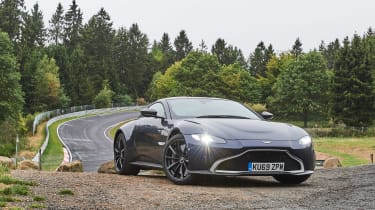Aston Martin Vantage (2018 - 2024) – design
Fast and fun Vantage is very different to its predecessor, but fun, and faster than ever
So there’s always been a critical factor to the current Aston Martin Vantage’s exterior design which has inexorably held it back. Its predecessor, the V8 Vantage from 2005, is quite possibly the best bit of contemporary car design ever. Henrik Fisker, who also penned the larger DB9, gave the Vantage some almost impossibly stunning lines, shrink wrapping his technical yet finessed surfacing style atop the VH-II platform with stunning results.
This no doubt made life very difficult for Aston Martin and its current EVP and creative technical officer Marek Reichman, who didn’t just have to reimagine the Vantage, but do so in an environment of ever more technical, complicated and exaggerated forms that the market demands. Reichman had all the tools, though, with an equally stunning set of proportions and a remit to create something with more visual aggression.
It’s safe to say that initial responses didn’t go down too well, largely on account of the ‘Hunter’ grille. This first, large-scale adaptation of the classic Aston grille shape occupied the front end’s lower fascia, but left only the tiny, somewhat unresolved headlights to break up the huge unadorned clamshell bonnet. Other elements, such as the somewhat awkward lighting signature at the rear, over-accentuated lower sills and rear diffuser all overrode the Vantage’s stunning proportions.
More reviews
Other elements were marred by production processes that turned otherwise extremely clever and brave details into clumsy points of contention. Things such as the unresolved junctions surrounding the side strake between the clamshell bonnet, lower wing panel and front door didn’t sit right – how could they with three different panels, each made from three different materials via different manufacturing processes.
Yet look beyond these elements and the overall design is not defined by its huge arches, grille or clumsy details, but the fact Reichman and his team bravely decided not to give the Vantage a typical wedge (or rising beltline towards the rear), but instead a falling tail as it reached the pert rear, leaving the cab and its trailing edge to form the distinctive ducktail on its own. The Hunter grille was another moment of brilliance, as it allowed the bonnet’s surfacing to do the talking – something the non-metallic chartreuse yellow launch colour seen on the first publicly viewed examples completely masked.
With tighter shut lines, a more resolved side strake, a removal of the rear light bar (which did little more than make for some messy junctions around the tail and exaggerate the narrow cab) and a finer hand to the lower sills, splitter and diffuser, the current Vantage might well have been just as visually successful as its superb predecessor.
Unfortunately, the modifications made by the team in subsequent Roadster and F1 Edition models haven’t helped – the traditional slatted grille only makes the nose look even more contrived (thankfully the original grille is still available). Despite these issues, though, the Vantage is still a spectacular-looking vehicle, especially when moving through a landscape as opposed to rotating on a motor show turntable.





